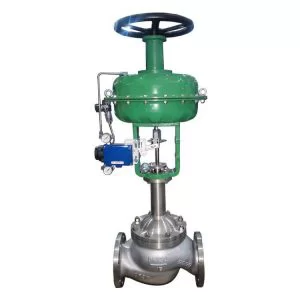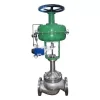An On-Off Valve is a type of valve used in various industries, including oil and gas, petrochemical, and water treatment. It is a type of valve that is used to control the flow of fluids or gases through a pipeline. The On-Off Valve is one of the most common valves used in industrial applications due to its simplicity, durability, and cost-effectiveness.
What is an On-Off Valve?
An On-Off Valve is a type of valve that can either be fully open or fully closed. It is a two-position valve that is used to either allow fluid or gas to flow through a pipeline or to stop the flow entirely. On-Off Valves are commonly used to control the flow of liquids, gases, and slurries. They are also used to isolate equipment or systems for maintenance or repair purposes.
 On-Off Valve
On-Off ValveTypes of On-Off Valves
There are several types of On-Off Valves, including ball valves, gate valves, butterfly valves, and globe valves.
Ball Valves
Ball valves are one of the most common types of On-Off Valves. They consist of a ball with a hole in the center that can be rotated to either allow or stop the flow of fluid or gas.
Gate Valves
Gate valves are another common type of On-Off Valve. They consist of a gate or wedge that is lowered into a slot in the valve body to stop the flow of fluid or gas.
Butterfly Valves
Butterfly valves are also commonly used as On-Off Valves. They consist of a disk that rotates to either allow or stop the flow of fluid or gas.
Globe Valves
Globe valves are a type of On-Off Valve that is used to regulate the flow of fluid or gas. They consist of a disk that moves up and down to control the flow of fluid or gas through the valve.
Applications of On-Off Valves
On-Off Valves are used in a wide variety of applications, including:
Oil and Gas Industry: On-Off Valves are used in the oil and gas industry to control the flow of crude oil, natural gas, and other fluids through pipelines.
Water Treatment: On-Off Valves are used in water treatment plants to control the flow of water through the treatment process.
Petrochemical Industry: On-Off Valves are used in the petrochemical industry to control the flow of chemicals and gases through pipelines.
Food and Beverage Industry: On-Off Valves are used in the food and beverage industry to control the flow of liquids and gases through the manufacturing process.
Benefits of On-Off Valves
On-Off Valves offer several benefits, including:
Simplicity: On-Off Valves are simple in design and easy to operate.
Durability: On-Off Valves are designed to withstand harsh operating conditions and have a long service life.
Cost-Effective: On-Off Valves are cost-effective compared to other types of valves, making them a popular choice in various industries.
Versatility: On-Off Valves can be used in a wide variety of applications and are suitable for controlling the flow of liquids, gases, and slurries.
On-Off Valves are a type of valve used in various industries to control the flow of fluids or gases through pipelines. They are simple in design, durable, and cost-effective. There are several types of On-Off Valves, including ball valves, gate valves, butterfly valves, and globe valves. On-Off Valves are used in a wide variety of applications, including the oil and gas industry, water treatment plants, and the petrochemical industry.
what type of actuator use in on off valve?
On-Off Valves can be actuated by a variety of mechanisms, depending on the specific application and requirements. The most common types of actuators used in On-Off Valves include:
- Manual Actuators: Manual actuators are the simplest and most common type of actuator used in On-Off Valves. They consist of a handwheel or lever that is used to manually open or close the valve. Manual actuators are suitable for small valves and low-pressure applications where the valve needs to be operated infrequently.
- Pneumatic Actuators: Pneumatic actuators use compressed air to open and close the valve. They are commonly used in industrial applications where the valve needs to be operated quickly and frequently. Pneumatic actuators are suitable for high-pressure applications and can be used in hazardous environments.
- Electric Actuators: Electric actuators use an electric motor to open and close the valve. They are commonly used in applications where the valve needs to be operated remotely or where the valve needs to be opened and closed frequently. Electric actuators are suitable for both high-pressure and low-pressure applications.
- Hydraulic Actuators: Hydraulic actuators use hydraulic pressure to open and close the valve. They are commonly used in high-pressure applications and can be used in hazardous environments. Hydraulic actuators are suitable for large valves and applications where a high level of precision is required.
- Solenoid Actuators: Solenoid actuators use an electromagnet to open and close the valve. They are commonly used in low-pressure applications where the valve needs to be operated quickly and frequently. Solenoid actuators are suitable for applications where a high level of precision is not required.
In summary, On-Off Valves can be actuated by a variety of mechanisms, including manual, pneumatic, electric, hydraulic, and solenoid actuators, depending on the specific application and requirements.
Difference between control valve and On-Off valve
Control valves and On-Off valves are two types of valves used in fluid control applications. While both types of valves are used to control the flow of fluid, there are significant differences between the two.
The main difference between control valves and On-Off valves is the degree of control they offer. Control valves provide precise control over the flow rate, pressure, and direction of the fluid, while On-Off valves only provide two positions – fully open or fully closed.
This are designed to operate in a wide range of flow conditions and are used to regulate the flow of fluid to maintain a desired setpoint or condition. Control valves have a variety of components, such as sensors, positioners, and controllers, that work together to ensure precise control. They can be used to regulate the flow of fluid based on various parameters, such as pressure, temperature, flow rate, or level.
On-Off valves, on the other hand, are designed to either fully open or fully close the flow of fluid. They are used to isolate a section of piping or to allow fluid to flow through a system at full capacity. On-Off valves are typically used in applications where precise control is not required, or where the valve is operated infrequently.
Another key difference between control valves and On-Off valves is their cost. Control valves are typically more expensive than On-Off valves due to the additional components required for precise control. On-Off valves, on the other hand, are relatively simple and less expensive.


